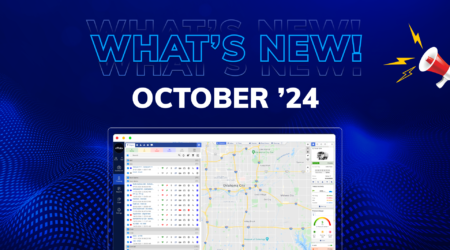LBS Tracking: Everything You Need to Know
Introduction to LBS Tracking
In the digital world, Location-Based Services (LBS) tracking stands out. It revolutionizes business operations, customer service, and resource optimization. At its heart, LBS tracking taps into mobile and network data for instant location details. Crucially, it boosts fleet management software with unmatched insights into vehicle locations, routes, and driver behavior.
Moreover, LBS tracking integration empowers businesses with precise data. Consequently, they make smarter decisions, cut costs, and elevate service quality. Logistics and public transport firms alike are embracing LBS tracking. As a result, they’re achieving greater efficiency, safety, and environmental sustainability in fleet management.
Exploring LBS tracking’s mechanics and fleet management role is vital. We aim to demystify its foundations, advantages, and trending developments. This blog serves as a detailed guide to LBS tracking. It provides key insights for businesses eager to advance their fleet management with technology.
How LBS Tracking Works?
Understanding the technicalities of Location-Based Services (LBS) tracking is essential for leveraging its full potential in fleet management. At its most basic, LBS tracking involves determining the geographical location of a device, typically a mobile phone or vehicle telematics unit, using a combination of GPS satellites, cell tower data, and Wi-Fi signals.
GPS Technology: The Global Positioning System (GPS) is a network of satellites orbiting the Earth, providing precise location data to GPS receivers on the ground. In fleet management, vehicles equipped with GPS devices can be tracked in real-time, offering accurate information on their whereabouts.
Cell Tower Triangulation: In areas where GPS signals are weak or unavailable, such as urban canyons, LBS tracking can utilize the signal strength from nearby cell towers to triangulate a device’s location. This method, while less precise than GPS, ensures continuous tracking capabilities across diverse environments.
Wi-Fi Positioning: Similarly, Wi-Fi positioning systems can determine a device’s location based on the proximity to Wi-Fi networks. This technique shines in indoor or crowded urban areas, where GPS and cell signals might get blocked.
By integrating these technologies, advanced fleet management software utilizes LBS tracking for a full view of operations. It lets businesses track vehicles, improve routes, and quickly react to conditions, boosting efficiency and service quality.
Difference between GPS and LBS Tracking
Certainly, understanding the difference between GPS (Global Positioning System) and LBS (Location-Based Services) tracking is crucial for anyone looking to implement or use location technologies. Both play significant roles in the realm of navigation, fleet management, and a multitude of applications requiring location intelligence. However, they operate on different principles and have distinct applications and limitations. Here’s a comprehensive comparison:
Fundamental Differences
GPS Tracking:
- Technology Basis: Utilizes a network of satellites orbiting the Earth to provide precise location information to GPS receivers on the ground.
- Accuracy: Offers high accuracy, typically within a few meters under open skies.
- Dependency: Operates independently of any cellular or internet network, relying solely on satellite signals.
- Primary Use Cases: Widely used for navigation, mapping, and tracking in outdoor environments where a clear line of sight to satellites is available.
LBS Tracking:
- Technology Basis: Uses cellular network data (cell towers), Wi-Fi, and sometimes GPS to determine a device’s location.
- Accuracy: The accuracy can vary significantly. It’s generally less precise than GPS when relying solely on cell towers or Wi-Fi but can be enhanced with GPS data.
- Dependency: Requires a cellular or internet connection to gather and transmit location data, making it more versatile in urban and indoor environments.
- Primary Use Cases: Employed for a variety of applications, including local search and advertising, social networking, emergency services, and fleet management in areas where GPS signals may be obstructed.
Advantages of LBS Tracking for Fleet Management
The integration of LBS tracking into fleet management system brings a multitude of benefits, directly impacting operational efficiency, cost reduction, and customer satisfaction.
Real-Time Tracking: The cornerstone of LBS tracking is the ability to monitor vehicles in real-time. This immediate visibility allows fleet managers to make dynamic decisions, rerouting vehicles based on traffic conditions, weather, or emergencies, ensuring timely deliveries and service.
Route Optimization: LBS tracking enables the analysis of historical and real-time data to identify the most efficient routes. This not only reduces fuel consumption and wear and tear on vehicles but also maximizes the number of deliveries or service calls made in a day.
Improved Safety: Monitoring driver behavior and vehicle performance in real-time can significantly enhance safety. Fleet managers can identify risky behaviors, such as speeding or harsh braking, and implement training or interventions to mitigate accidents and liabilities.
Cost Reduction: By optimizing routes, improving safety, and enhancing vehicle maintenance through predictive insights, LBS tracking contributes to substantial cost savings. Reduced fuel consumption, lower insurance premiums, and decreased maintenance costs directly benefit the bottom line.
Compliance: Ensuring vehicles comply with regulatory requirements is simpler with LBS tracking. Fleet managers can monitor hours of service, rest periods, and maintenance schedules to adhere to industry regulations and standards.
Trends in LBS Tracking
The LBS tracking landscape is ever-evolving, fueled by tech improvements and a push for better fleet management. Several key trends are reshaping LBS tracking:
Integration of IoT and Telematics: The Internet of Things (IoT) is revolutionizing LBS tracking by enabling a network of connected devices to communicate and share data in real time. They allow devices to connect and share data quickly. This synergy boosts fleet management software. It provides deep insights into vehicle health, fuel usage, and driver actions. Consequently, it opens doors to predictive maintenance and smoother operations.
Advanced Data Analytics and AI: Artificial Intelligence (AI) and machine learning are being applied to the vast amounts of data generated by LBS tracking systems. These technologies provide predictive analytics, enabling fleet managers to anticipate issues, optimize routes more efficiently, and improve decision-making processes.
Increased Focus on Driver Safety and Behavior: LBS tracking technologies now incorporate advanced driver assistance systems (ADAS) and driver behavior monitoring tools. These innovations help in identifying risky behaviors, providing training opportunities, and improving overall fleet safety.
5G Connectivity: The rollout of 5G networks is set to significantly enhance LBS tracking capabilities. With faster data transmission and reduced latency, 5G enables more accurate real-time tracking, supports the transmission of richer data sets, and facilitates the deployment of autonomous vehicles.
Sustainability and Eco-friendly Practices: Environmental concerns are driving the adoption of LBS tracking technologies that support eco-friendly practices. Fleet systems now aim to cut carbon footprints via route optimization, fuel management, and adding electric vehicles (EVs) to fleets.
These trends highlight LBS tracking’s evolving role and its impact on fleet management’s future. Keeping up with these changes, businesses can boost efficiency, safety, and sustainability with LBS tracking.
Implementing LBS Tracking in Fleet Management
Adopting LBS tracking in fleet management involves a strategic approach to ensure seamless integration and maximization of benefits. Here are the steps and considerations for implementing LBS tracking within a fleet management system:
Assessment of Needs: Begin by assessing your fleet’s specific needs and objectives. Consider factors such as the size of the fleet, types of vehicles, operational challenges, and the desired outcomes from implementing LBS tracking.
Choosing the Right Solution: Select a fleet management software that integrates seamlessly with LBS tracking technologies and meets your operational requirements. Look for solutions that offer scalability, reliability, and comprehensive support.
Integration Process: Work closely with the software provider to integrate LBS tracking into your existing fleet management system. This may involve hardware installation in vehicles, software setup, and configuration to ensure accurate data collection and reporting.
Training and Support: Ensure that your team, including fleet managers and drivers, receive thorough training on the new system. Ongoing support from the software provider is crucial to address any technical issues and optimize the use of LBS tracking.
Data Analysis and Optimization: Once LBS tracking is operational, analyze the data to identify trends, inefficiencies, and opportunities for improvement. Continuous optimization of routes, maintenance schedules, and driver performance based on LBS data can significantly enhance fleet operations.
Types of technologies used in LBS
Location-Based Services (LBS) leverage a variety of technologies to determine the geographic location of a device. These technologies provide the backbone for a wide array of applications, from navigation and tracking to advertising and social networking. Understanding the different types of technologies used in LBS is essential for grasping how these services operate and their potential applications. Here’s an overview of the key technologies employed in LBS:
Global Positioning System (GPS)
- Description: GPS, a satellite-based system, uses a satellite network to send precise signals, enabling receivers to show accurate location, speed, and time.
- Applications: Used extensively in navigation for cars, planes, and ships, as well as in personal tracking devices, smartphones, and for mapping and surveying.
Cell ID
- Description: This technology determines a device’s location based on the cell tower to which the device is connected. The coverage area is divided into cells, each served by a tower. By knowing which tower a device is connected to, an approximate location can be determined.
- Applications: Useful in areas where GPS signals are weak or unavailable. Commonly used for basic mobile phone tracking and emergency call location.
Wi-Fi Positioning System (WPS)
- Description: WPS uses the signal strength of nearby Wi-Fi access points to determine a device’s location. Each Wi-Fi network has a unique identifier (MAC address) and by mapping these addresses, a location database can be created and used for positioning.
- Applications: Particularly effective in urban areas and indoors for location-based advertising, retail analytics, and providing indoor navigation solutions.
Bluetooth Low Energy (BLE) Beacons
- Description: BLE beacons are small wireless transmitters that broadcast Bluetooth signals at regular intervals. Devices like smartphones can detect these signals and, with the right software, determine their proximity to the beacon.
- Applications: Widely used for indoor positioning systems, such as in shopping malls, airports, and museums to offer navigation aids, proximity-based marketing, and location-based information services.
Near Field Communication (NFC)
- Description: NFC protocols let two electronic devices, often including a smartphone, communicate when brought close together, usually within a few centimeters.
- Applications: Although NFC doesn’t track location over distances, it’s vital for services like contactless payments, access control, and in-store promotions where location matters.
Geofencing
- Description: Location-based service that triggers an action when a mobile device enters or exits a predefined geographic area, known as a geofence. This technology uses GPS, RFID, Wi-Fi, or cellular data to define geographical boundaries.
- Applications: Used for security purposes, to track assets within a specific area, automate time cards in workplaces, send targeted advertisements, and in smart home applications.
Assisted GPS (A-GPS)
- Description: A-GPS is a system that improves the startup performance, or time-to-first-fix (TTFF), of a GPS satellite-based positioning system. It does this by using a combination of satellite and cellular network data to rapidly estimate the initial position.
- Applications: Enhances GPS performance in devices, especially in challenging environments like urban canyons, where GPS signals may be obstructed or reflected.
Conclusion
The versatility of Location-Based Services is evident in their widespread application across various industries and sectors. By leveraging precise location data, LBS enhances user experiences, improves operational efficiencies, and offers new ways for businesses to connect with customers. As technology advances, the potential uses of LBS continue to expand, promising even more innovative solutions in the future.





